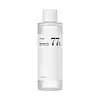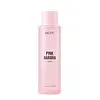What's inside
What's inside
 Key Ingredients
Key Ingredients

No key ingredients
 Benefits
Benefits

 Concerns
Concerns

No concerns
 Ingredients Side-by-side
Ingredients Side-by-side

Houttuynia Cordata Extract 77%
Skin ConditioningWater
Skin Conditioning1,2-Hexanediol
Skin ConditioningGlycerin
HumectantBetaine
HumectantPanthenol
Skin ConditioningSaccharum Officinarum Extract
MoisturisingPortulaca Oleracea Extract
Skin ConditioningButylene Glycol
HumectantVitex Agnus-Castus Extract
AstringentChamomilla Recutita Flower Extract
MaskingArctium Lappa Root Extract
Skin ConditioningPhellinus Linteus Extract
Skin ConditioningVitis Vinifera Fruit Extract
Skin ConditioningPyrus Malus Fruit Extract
Skin ConditioningCentella Asiatica Extract
CleansingIsopentyldiol
HumectantMethylpropanediol
SolventAcrylates/C10-30 Alkyl Acrylate Crosspolymer
Emulsion StabilisingTromethamine
BufferingDisodium EDTA
Houttuynia Cordata Extract 77%, Water, 1,2-Hexanediol, Glycerin, Betaine, Panthenol, Saccharum Officinarum Extract, Portulaca Oleracea Extract, Butylene Glycol, Vitex Agnus-Castus Extract, Chamomilla Recutita Flower Extract, Arctium Lappa Root Extract, Phellinus Linteus Extract, Vitis Vinifera Fruit Extract, Pyrus Malus Fruit Extract, Centella Asiatica Extract, Isopentyldiol, Methylpropanediol, Acrylates/C10-30 Alkyl Acrylate Crosspolymer, Tromethamine, Disodium EDTA
Citrullus Lanatus Fruit Extract
Skin ConditioningGlycerin
HumectantDipropylene Glycol
HumectantButylene Glycol
Humectant1,2-Hexanediol
Skin ConditioningIsopentyldiol
HumectantNiacinamide
SmoothingWater
Skin ConditioningBetaine
HumectantHydroxyethyl Urea
HumectantSodium Citrate
BufferingPropanediol
SolventAllantoin
Skin ConditioningPolyglyceryl-10 Laurate
Skin ConditioningCitric Acid
BufferingSalicylic Acid
MaskingEthylhexylglycerin
Skin ConditioningAdenosine
Skin ConditioningDisodium EDTA
Glyceryl Acrylate/Acrylic Acid Copolymer
HumectantLavandula Angustifolia Oil
MaskingCyanocobalamin
Skin ConditioningGlutathione
Sodium Ascorbyl Phosphate
AntioxidantTranexamic Acid
AstringentCalamine
AbsorbentMelaleuca Alternifolia Leaf Extract
PerfumingSodium Hyaluronate Crosspolymer
HumectantLactobacillus/Soybean Ferment Extract
Skin ConditioningHydrolyzed Glycosaminoglycans
HumectantDioscorea Japonica Root Extract
Skin ConditioningTremella Fuciformis Extract
HumectantHippophae Rhamnoides Fruit Extract
Skin ConditioningSodium Hyaluronate
HumectantBenzyl Glycol
SolventCentella Asiatica Extract
CleansingHydrolyzed Hyaluronic Acid
HumectantHyaluronic Acid
HumectantRaspberry Ketone
MaskingLinalool
PerfumingCitrullus Lanatus Fruit Extract, Glycerin, Dipropylene Glycol, Butylene Glycol, 1,2-Hexanediol, Isopentyldiol, Niacinamide, Water, Betaine, Hydroxyethyl Urea, Sodium Citrate, Propanediol, Allantoin, Polyglyceryl-10 Laurate, Citric Acid, Salicylic Acid, Ethylhexylglycerin, Adenosine, Disodium EDTA, Glyceryl Acrylate/Acrylic Acid Copolymer, Lavandula Angustifolia Oil, Cyanocobalamin, Glutathione, Sodium Ascorbyl Phosphate, Tranexamic Acid, Calamine, Melaleuca Alternifolia Leaf Extract, Sodium Hyaluronate Crosspolymer, Lactobacillus/Soybean Ferment Extract, Hydrolyzed Glycosaminoglycans, Dioscorea Japonica Root Extract, Tremella Fuciformis Extract, Hippophae Rhamnoides Fruit Extract, Sodium Hyaluronate, Benzyl Glycol, Centella Asiatica Extract, Hydrolyzed Hyaluronic Acid, Hyaluronic Acid, Raspberry Ketone, Linalool
 Reviews
Reviews

Ingredients Explained
These ingredients are found in both products.
Ingredients higher up in an ingredient list are typically present in a larger amount.
1,2-Hexanediol is a synthetic liquid and another multi-functional powerhouse.
It is a:
- Humectant, drawing moisture into the skin
- Emollient, helping to soften skin
- Solvent, dispersing and stabilizing formulas
- Preservative booster, enhancing the antimicrobial activity of other preservatives
Betaine is a common humectant (a substance that promotes retention of moisture). It's known to be gentle on the skin and can help balance hydration.
This ingredient is best for improving hydration and soothing irritated skin. Studies also show it helps even out skin tone.
Fun fact: Betaine is naturally created in the skin and body. The kind found within cosmetic products can be either plant-derived or synthetic.
Another name for betaine is trimethylglycine.
Learn more about BetaineButylene Glycol (or BG) is used within cosmetic products for a few different reasons:
Overall, Butylene Glycol is a safe and well-rounded ingredient that works well with other ingredients.
Though this ingredient works well with most skin types, some people with sensitive skin may experience a reaction such as allergic rashes, closed comedones, or itchiness.
Learn more about Butylene GlycolCentella Asiatica Extract (Centella) is derived from an herb native to Southeast Asia. It is famous for its anti-inflammatory and soothing properties.
Centella is rich in antioxidants and amino acids, such as Madecassic Acid and Asiaticoside.
Studies show the compounds in centella help with:
The combination of all these properties makes centella effective at soothing, hydrating, and protecting the skin.
Other great components of centella include Vitamin A, vitamin C, several B vitamins, and Asiatic Acid.
Fun fact: Centella has been used as a medicine and in food for many centuries. As a medicine, it is used to treat burns, scratches, and wounds.
Learn more about Centella Asiatica ExtractDisodium EDTA plays a role in making products more stable by aiding other preservatives.
It is a chelating agent, meaning it neutralizes metal ions that may be found in a product.
Disodium EDTA is a salt of edetic acid and is found to be safe in cosmetic ingredients.
Learn more about Disodium EDTAGlycerin is already naturally found in your skin. It helps moisturize and protect your skin.
A study from 2016 found glycerin to be more effective as a humectant than AHAs and hyaluronic acid.
As a humectant, it helps the skin stay hydrated by pulling moisture to your skin. The low molecular weight of glycerin allows it to pull moisture into the deeper layers of your skin.
Hydrated skin improves your skin barrier; Your skin barrier helps protect against irritants and bacteria.
Glycerin has also been found to have antimicrobial and antiviral properties. Due to these properties, glycerin is often used in wound and burn treatments.
In cosmetics, glycerin is usually derived from plants such as soybean or palm. However, it can also be sourced from animals, such as tallow or animal fat.
This ingredient is organic, colorless, odorless, and non-toxic.
Glycerin is the name for this ingredient in American English. British English uses Glycerol/Glycerine.
Learn more about GlycerinIsopentyldiol is a synthetic solvent, humectant, and emollient.
Humectants have the ability to attract and hold water while emollients create a thin film to prevent water from evaporating. This combination keeps your skin and hair soft and hydrated. Plus, isopentyldiol does not leave a sticky feeling behind.
As a surfactant, isopentyldiol is a hydrotrope. Hydrotropes help surfactants (cleansing agents) dissolve into water.
According to the manufacturer, using this ingredient with sorbitol boosts skin hydration and helps close cuticles of damaged hair.
This ingredient is water-soluble.
Learn more about IsopentyldiolWater. It's the most common cosmetic ingredient of all. You'll usually see it at the top of ingredient lists, meaning that it makes up the largest part of the product.
So why is it so popular? Water most often acts as a solvent - this means that it helps dissolve other ingredients into the formulation.
You'll also recognize water as that liquid we all need to stay alive. If you see this, drink a glass of water. Stay hydrated!
Learn more about Water